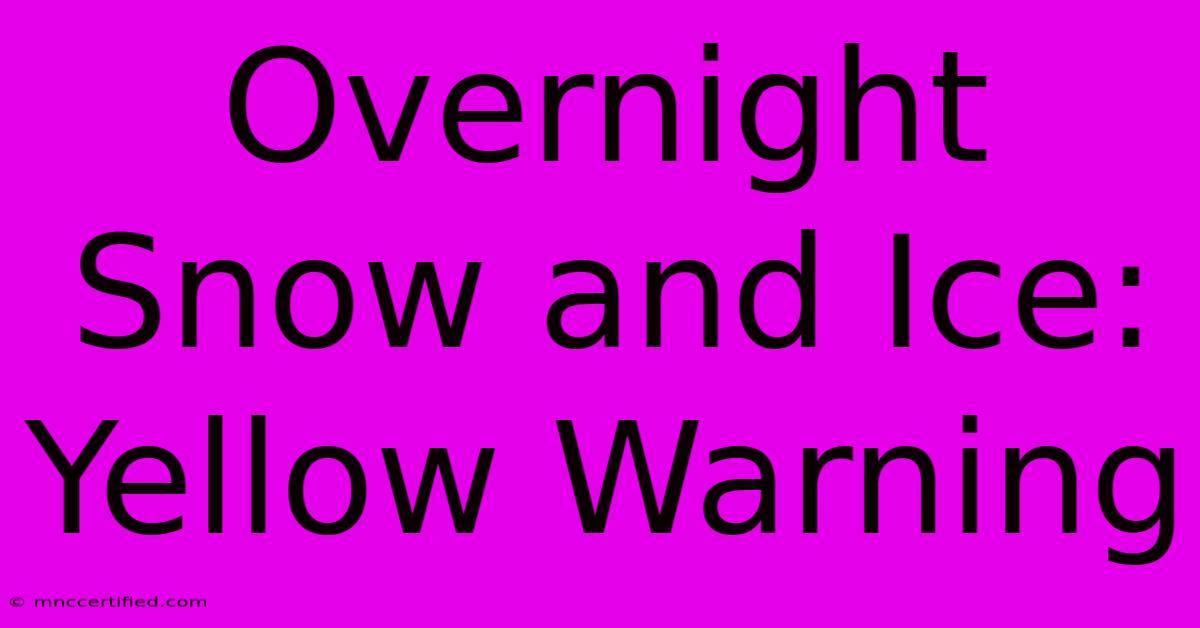Overnight Snow And Ice: Yellow Warning

Table of Contents
Overnight Snow and Ice: Yellow Warning - What You Need to Know
An overnight yellow warning for snow and ice means trouble. While not as severe as red or amber warnings, it still signifies a potential disruption to travel and daily life. This post will guide you through understanding the warning, preparing for the icy conditions, and staying safe during and after the event.
Understanding the Yellow Warning
A Met Office (or your country's equivalent weather service) yellow warning for snow and ice indicates that travel delays and disruptions are possible. This means:
- Some roads and railways are likely to be affected with longer journey times by road, bus and train services. Be prepared for potential delays and cancellations.
- There is a chance of injuries from slips and falls on icy surfaces. Take extra care when walking outdoors.
- Power cuts are possible, and other services may be temporarily disrupted. Ensure you have a plan in place in case of power outages.
This warning isn't a cause for immediate panic, but it's a strong indication that you should take precautions. The key takeaway is preparedness. Don't underestimate the impact of even a small amount of snow and ice.
What to Expect
Depending on your location and the specific details of the warning, you might experience:
- Light to moderate snowfall: Accumulation might be minimal in some areas, but enough to cause slippery conditions.
- Freezing rain or sleet: This is particularly dangerous as it forms a thin, transparent layer of ice on surfaces, making them extremely slippery and difficult to detect.
- Icy patches: Even without significant snowfall, overnight temperatures can cause icy patches on roads, pavements, and other surfaces.
Preparing for Snow and Ice
Preparation is key to minimizing disruption and staying safe during a yellow warning. Here's what you should do:
Before the Snow and Ice Arrives:
- Check the forecast: Monitor weather updates closely for the latest information and potential changes to the warning.
- Stock up on essentials: Have enough food, water, and medication on hand in case you're stuck at home.
- Charge devices: Ensure your phone and other electronic devices are fully charged.
- Prepare your car: Check your car's antifreeze, screenwash, and tyre pressure. Keep a scraper, warm blanket, and a shovel in your car.
- Clear walkways: Clear any snow or ice from around your home, particularly steps and pathways. Use salt or grit for extra traction.
During the Snow and Ice:
- Avoid unnecessary travel: If possible, stay home and avoid driving unless absolutely necessary.
- Drive slowly and carefully: If you must drive, allow extra time for your journey, drive slowly, and maintain a safe distance from other vehicles.
- Walk carefully: Wear appropriate footwear with good grip and take your time. Avoid rushing.
- Stay warm: Dress in layers and keep warm indoors.
Staying Safe After the Snow and Ice
Even after the warning is lifted, icy patches may persist, especially in shaded areas. Continue to exercise caution and:
- Check for black ice: Black ice is invisible and particularly dangerous. Be extra careful on roads, pavements, and bridges.
- Clear remaining snow and ice: Continue to clear walkways and driveways to prevent accidents.
- Monitor weather updates: Stay informed about potential further weather warnings.
Key Takeaways for Staying Safe During a Yellow Warning
- Preparation is paramount. Take the warning seriously and prepare accordingly.
- Prioritize safety. Avoid unnecessary risks and stay informed.
- Be aware of your surroundings. Watch out for icy patches and slippery surfaces.
By following these tips, you can minimize the risks associated with overnight snow and ice during a yellow warning and ensure your safety and well-being. Remember to always check your local weather service for the most up-to-date and accurate information.

Thank you for visiting our website wich cover about Overnight Snow And Ice: Yellow Warning. We hope the information provided has been useful to you. Feel free to contact us if you have any questions or need further assistance. See you next time and dont miss to bookmark.
Featured Posts
-
Spirit Files For Chapter 11
Nov 19, 2024
-
Paytons Impact Bo Nixs Broncos Rise
Nov 19, 2024
-
When Does Dune Prophecy Air
Nov 19, 2024
-
Kelce Blends Streetwear High End Fashion
Nov 19, 2024
-
Kelce Swift Face Bills Fans Ire
Nov 19, 2024